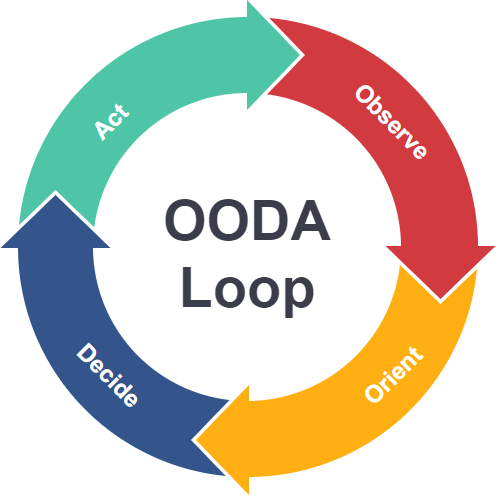OODA Loop
Author: Roger C.B. Johnsen
Introduction
The OODA Loop is a decision-making framework developed by military strategist and United States Air Force Colonel John Boyd. It stands for Observe, Orient, Decide, and Act. The model is designed to be a cyclical process that helps individuals and organizations make decisions more effectively, especially in competitive and high-stakes environments.
About model
The OODA loop is most often depicted as a “wheel” to symbolize a loop, like this:
Courtesy of online.visual-paradigm.com
OODA Loop Components
As we can see, this model consists of four components:
Observe:
- Gather Information: Collect data from the environment, including any changes or new information.
- Identify Key Elements: Note important factors such as opponent actions, environmental conditions, and any anomalies.
- Recognize Changes: Be aware of shifts in the situation that may require a reassessment.
Orient:
- Analyze Information: Process the data gathered during the observation phase.
- Set Context: Use cultural, genetic, and previous experiences to understand the significance of the information.
- Synthesize Data: Integrate new information with existing knowledge to create a coherent picture of the situation.
Decide:
- Develop Options: Consider various courses of action based on the orientation phase.
- Evaluate Options: Assess the potential effectiveness and consequences of each option.
- Select a Course of Action: Choose the most appropriate response based on the current understanding of the situation.
Act:
- Implement the Decision: Carry out the chosen course of action.
- Monitor Results: Observe the effects of the action taken.
- Adapt as Necessary: Make adjustments based on the results and feedback, which feeds back into the observation phase.
Practical application
The OODA Loop, originally developed for military strategy, has found widespread application in various fields such as business, sports, and personal decision-making. Its core strength lies in promoting rapid and informed decision-making, which is crucial in dynamic and competitive environments. This model is particularly important because it mirrors how humans naturally react and make decisions under stress, making it highly intuitive and effective.
In practical terms, the OODA Loop comprises four stages: Observe, Orient, Decide, and Act. Each stage is critical for processing information and responding appropriately. For instance, in a Security Operations Center (SOC), the Observe phase involves monitoring network traffic and system alerts to identify potential threats. The Orient phase requires analyzing this data to understand the context and implications of these threats. In the Decide phase, the SOC team formulates a response strategy based on their analysis. Finally, in the Act phase, they implement the response, mitigate the threat, and document the incident for future reference. Or - if needed, the loop is restarted taking what we’ve learned so far into a new iteration in the OODA loop. For it is an iterative model!
For threat hunters the OODA loop turns into a mantra on its own (with some minor adjustments):
Observe - Orient - Decide - Act - Repeat
The importance of the OODA Loop in a SOC and for threat hunters cannot be overstated. Cybersecurity environments are inherently volatile, with new threats emerging constantly. The ability to quickly observe changes, orient to the new reality, decide on the best course of action, and act promptly is essential for minimizing damage and maintaining operational integrity. Furthermore, this model’s emphasis on continuous observation and adaptation ensures that security teams remain agile and responsive, always ready to tackle new challenges.
The OODA Loop’s relevance extends beyond structured environments like SOCs. It reflects a fundamental aspect of human behavior, as we unconsciously apply this process in our daily lives. Whether it’s deciding how to react in a conversation, choosing the quickest route home, or handling unexpected situations, we rely on observing, orienting, deciding, and acting. Recognizing and harnessing this natural decision-making framework can enhance our ability to function effectively under pressure, making the OODA Loop not just a strategic tool, but a vital part of the human backbone in stressful environments.
Resources
For more detailed information and examples of the OODA Loop in practice, you can visit these resources:
These sources provide a comprehensive overview of the OODA Loop and its various applications.
Revision
| Revised Date | Comment |
|---|---|
| 06.10.2024 | Improved formatting and wording |
